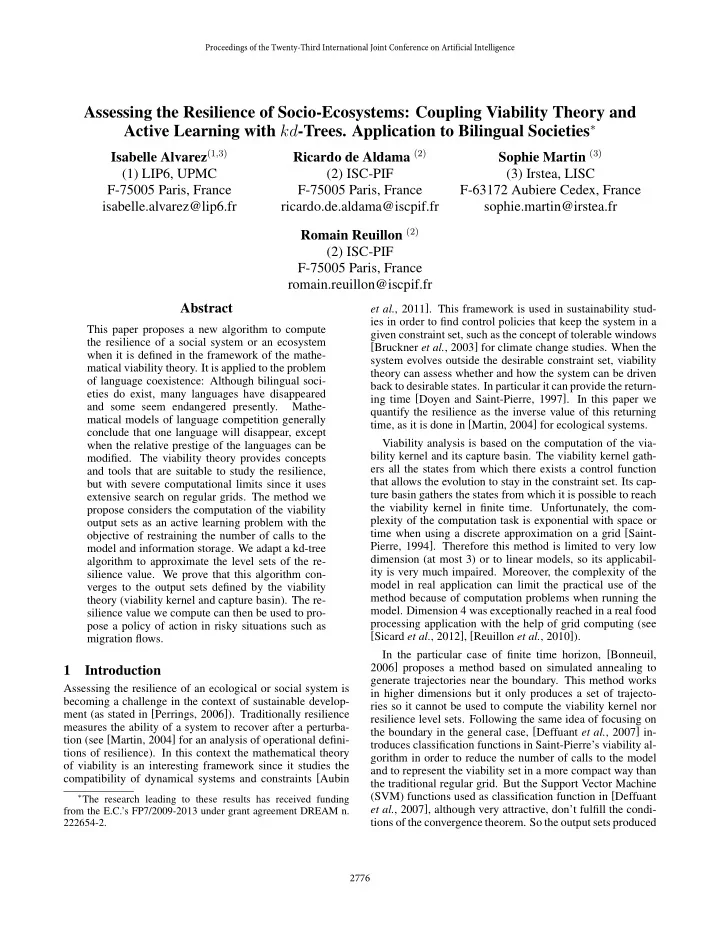

Proceedings of the Twenty-Third International Joint Conference on Artificial Intelligence Assessing the Resilience of Socio-Ecosystems: Coupling Viability Theory and Active Learning with kd -Trees. Application to Bilingual Societies ∗ Isabelle Alvarez (1 , 3) Ricardo de Aldama (2) Sophie Martin (3) (1) LIP6, UPMC (2) ISC-PIF (3) Irstea, LISC F-75005 Paris, France F-75005 Paris, France F-63172 Aubiere Cedex, France isabelle.alvarez@lip6.fr ricardo.de.aldama@iscpif.fr sophie.martin@irstea.fr Romain Reuillon (2) (2) ISC-PIF F-75005 Paris, France romain.reuillon@iscpif.fr Abstract et al. , 2011]. This framework is used in sustainability stud- ies in order to find control policies that keep the system in a This paper proposes a new algorithm to compute given constraint set, such as the concept of tolerable windows the resilience of a social system or an ecosystem [Bruckner et al. , 2003] for climate change studies. When the when it is defined in the framework of the mathe- system evolves outside the desirable constraint set, viability matical viability theory. It is applied to the problem theory can assess whether and how the system can be driven of language coexistence: Although bilingual soci- back to desirable states. In particular it can provide the return- eties do exist, many languages have disappeared ing time [Doyen and Saint-Pierre, 1997]. In this paper we and some seem endangered presently. Mathe- quantify the resilience as the inverse value of this returning matical models of language competition generally time, as it is done in [Martin, 2004] for ecological systems. conclude that one language will disappear, except Viability analysis is based on the computation of the via- when the relative prestige of the languages can be bility kernel and its capture basin. The viability kernel gath- modified. The viability theory provides concepts ers all the states from which there exists a control function and tools that are suitable to study the resilience, that allows the evolution to stay in the constraint set. Its cap- but with severe computational limits since it uses ture basin gathers the states from which it is possible to reach extensive search on regular grids. The method we the viability kernel in finite time. Unfortunately, the com- propose considers the computation of the viability plexity of the computation task is exponential with space or output sets as an active learning problem with the time when using a discrete approximation on a grid [Saint- objective of restraining the number of calls to the Pierre, 1994]. Therefore this method is limited to very low model and information storage. We adapt a kd-tree dimension (at most 3) or to linear models, so its applicabil- algorithm to approximate the level sets of the re- ity is very much impaired. Moreover, the complexity of the silience value. We prove that this algorithm con- model in real application can limit the practical use of the verges to the output sets defined by the viability method because of computation problems when running the theory (viability kernel and capture basin). The re- model. Dimension 4 was exceptionally reached in a real food silience value we compute can then be used to pro- processing application with the help of grid computing (see pose a policy of action in risky situations such as [Sicard et al. , 2012], [Reuillon et al. , 2010]). migration flows. In the particular case of finite time horizon, [Bonneuil, 2006] proposes a method based on simulated annealing to 1 Introduction generate trajectories near the boundary. This method works Assessing the resilience of an ecological or social system is in higher dimensions but it only produces a set of trajecto- becoming a challenge in the context of sustainable develop- ries so it cannot be used to compute the viability kernel nor ment (as stated in [Perrings, 2006]). Traditionally resilience resilience level sets. Following the same idea of focusing on measures the ability of a system to recover after a perturba- the boundary in the general case, [Deffuant et al. , 2007] in- tion (see [Martin, 2004] for an analysis of operational defini- troduces classification functions in Saint-Pierre’s viability al- tions of resilience). In this context the mathematical theory gorithm in order to reduce the number of calls to the model of viability is an interesting framework since it studies the and to represent the viability set in a more compact way than compatibility of dynamical systems and constraints [Aubin the traditional regular grid. But the Support Vector Machine (SVM) functions used as classification function in [Deffuant ∗ The research leading to these results has received funding et al. , 2007], although very attractive, don’t fulfill the condi- from the E.C.’s FP7/2009-2013 under grant agreement DREAM n. 222654-2. tions of the convergence theorem. So the output sets produced 2776
Recommend
More recommend